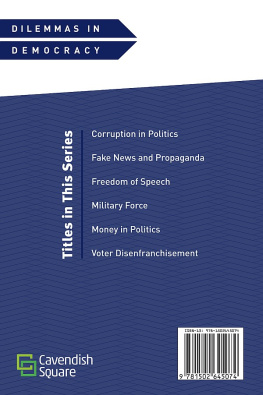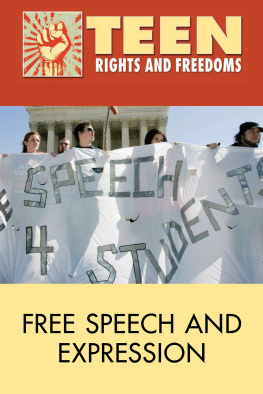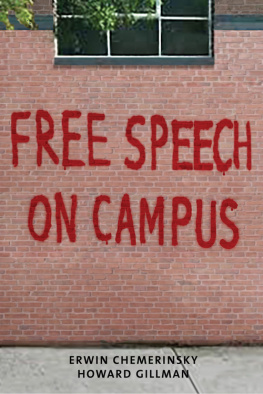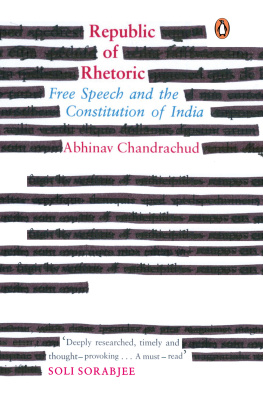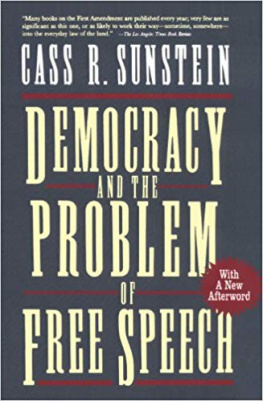
Published in 2020 by Cavendish Square Publishing, LLC
243 5th Avenue, Suite 136, New York, NY 10016
Copyright 2020 by Cavendish Square Publishing, LLC
First Edition
No part of this publication may be reproduced, stored in a retrieval system, or transmitted in any form or by any meanselectronic, mechanical, photocopying, recording, or otherwisewithout the prior permission of the copyright owner. Request for permission should be addressed to Permissions, Cavendish Square Publishing, 243 5th Avenue,
Suite 136, New York, NY 10016. Tel (877) 980-4450; fax (877) 980-4454.
Website: cavendishsq.com
This publication represents the opinions and views of the author based on his or her personal experience, knowledge, and research. The information in this book serves as a general guide only. The author and publisher have used their best efforts in preparing this book and disclaim liability rising directly or indirectly from the use and application of this book.
All websites were available and accurate when this book was sent to press.
Library of Congress Cataloging-in-Publication Data
Names: Johnson, Anna Maria, author.
Title: Freedom of speech / Anna Maria Johnson.
Description: First edition. | New York: Cavendish Square, 2020. |
Series: Dilemmas in democracy | Includes bibliographical references and index. |
Audience: Grade 7 to 12.
Identifiers: LCCN 2018061293 (print) | LCCN 2019002322 (ebook) | ISBN 9781502645081 (ebook) | ISBN 9781502645074 (library bound) | ISBN 9781502645067 (pbk.)
Subjects: LCSH: Freedom of speech--Juvenile literature. |
Freedom of speech--United States--Juvenile literature.
Classification: LCC JC591 (ebook) | LCC JC591 .J63 2020 (print) | DDC 323.44/30973--dc23
LC record available at https://lccn.loc.gov/2018061293
Editorial Director: David McNamara
Editor: Caitlyn Miller
Copy Editor: Alex Tessman
Associate Art Director: Alan Sliwinski
Designer: Christina Shults
Production Coordinator: Karol Szymczuk
Photo Research: J8 Media
The photographs in this book are used by permission and through the courtesy of:
Cover Tony Tallec/Alamy Stock Photo; background (and used throughout the book) Artist Elizaveta/ .
Printed in the United States of America
CONTENTS
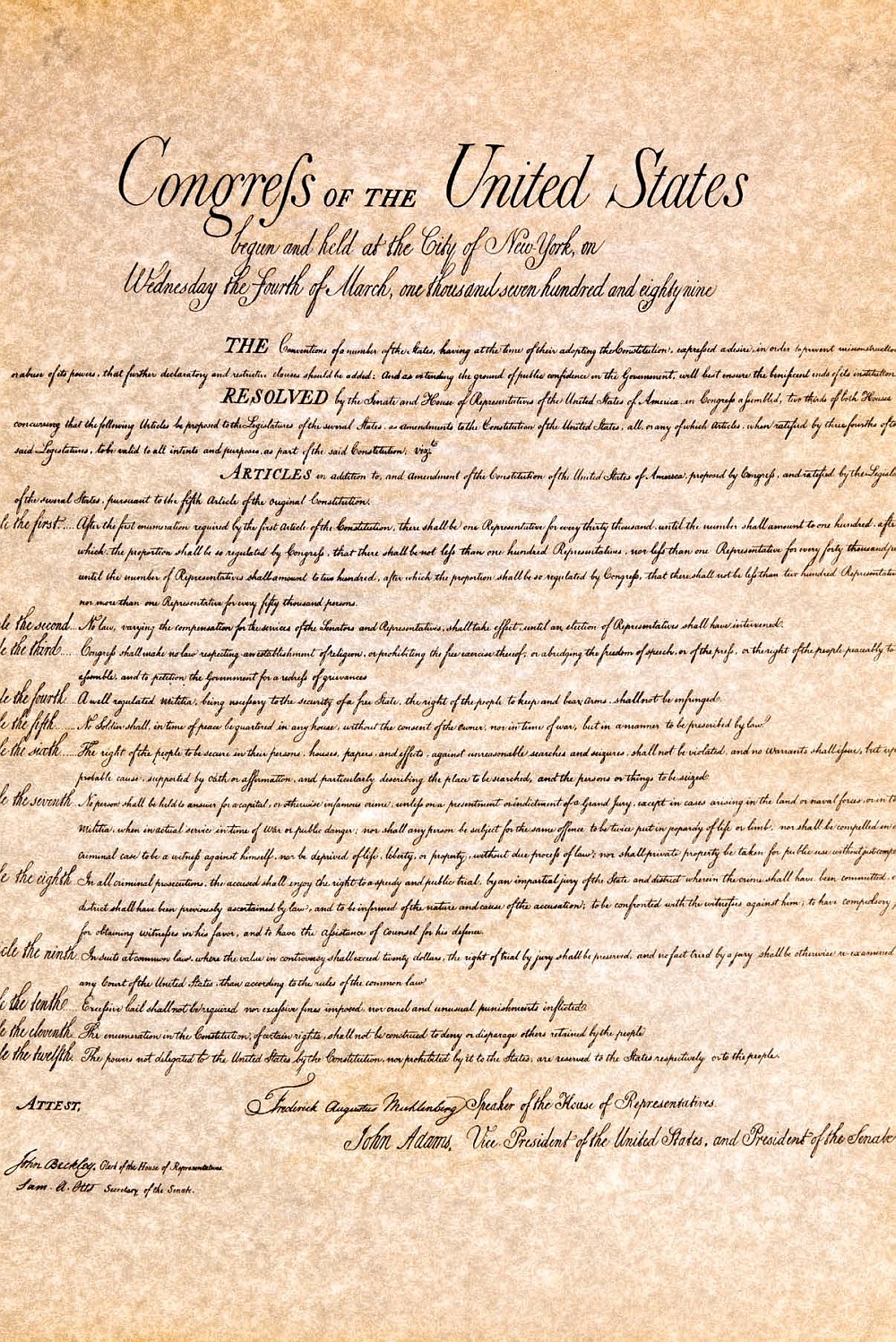
The Bill of Rights consists of ten amendments to the US Constitution. Freedom of speech is part of the First Amendment.
CHAPTER 1
What Is Freedom of Speech?
B efore the United States Constitution was ratified, the Founding Fathers debated for months about what rights should be included. Some believed that anything that wasnt mentioned in the Constitution would be left to the state governments. Others believed that certain rights should be stated as a guarantee of protection for Americans. They worried that if rights were not written down, people might not have them in the future. Thomas Jefferson told James Madison, Half a loaf is better than no bread. If we cannot secure all rights, let us secure what we can.
As a result of this conversation, ten amendments, together called the Bill of Rights, were added to the Constitution in 1791. The First Amendment grants Americans five specific freedoms, including the freedom of speech. Free speech is closely related to the freedom of religion and religious expression. It also relates to freedom of the press, which means the right to publish information for the public to read. The rights to peacefully assemble and to ask the government to make changes to policy have been interpreted to allow nonviolent protests of all types within the nation. The First Amendment says:
Congress shall make no law respecting an establishment of religion, or prohibiting the free exercise thereof; or abridging the freedom of speech, or of the press; or the right of the people peaceably to assemble, and to petition the Government for a redress of grievances.
In other words, the federal (national) government may not choose for its citizens which religion they must believe or practice. The federal government must allow its people to speak their minds without fear of punishment, and the press must be able to write and publish freelyeven when theyre critical of the government. Finally, people must not be limited from gathering together and asking their government for changes.
These five rightsthe freedom of religion, freedom of speech, freedom of the press, the right to assembly, and the right to protest are the foundations of American democracy. The First Amendment has also inspired similar protections in other democracies throughout the world. The 1942 Universal Declaration of Human Rights borrows from this language as well. This document was created after World War II by people who believed that all human beings should have certain rights. It was designed to be something like a Bill of Rights for all people.
Across the board, freedom of speech and freedom of expression are highly valued in democracies. Without such freedoms, governments could refuse to listen to people who voice concerns or criticisms about injustice and unfair laws. In countries without freedom of speech, citizens must be careful never to criticize or complain in public about their government because they could risk going to jail for doing so. Since a democracy is based on the idea of government by the people, freedom of speech is essential. It allows citizens to participate fully in the process of government.
Censorship
The opposite of freedom of speech is censorship. Censorship is when news, books, films, or other sources of information are removed or withheld, in full or in part, by an authority figure. Censorship occurs when authorities decide something is obscene, unacceptable for political reasons, or a threat to security. Censorship can occur on many levels ranging from the federal government, to state and local governments, local school districts, and even on specific digital platforms and sites.
One common example of censorship is when certain books are banned from libraries or from a school curriculum. People from different political views have wished to censor books for different reasons. For example, some books have been banned for being too violent or sexually explicit. Other books have been banned for using offensive or racist language.
During a time of war, governments might censor some information in order to protect national security. Historically, this has often led to controversies or mistrust when people later found out that vital information was kept secret.

Starting in 1982, the American Library Association has celebrated Banned Books Week each year in September. Librarians, bookstores, teachers, and readers share their support for the freedom to read and express ideas.
Regulating Free Speech
It is important to note that there is a difference between censorship (which is often seen as negative) and normal regulations that are needed in order to promote safety and the functioning of a healthy democracy.
In the United States, the First Amendment has been interpreted by the courts during the past century to generally increase protections. American citizens have the ability to express their opinions and ideas even when those ideas are critical of the government. However, freedom of speech is not absolute. Over time, some limitations have been defined too. These limitations have usually been determined as the result of court cases. The Supreme Court has ruled that certain kinds of harmful speech are not allowed.

